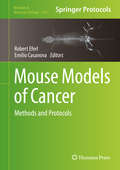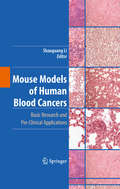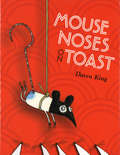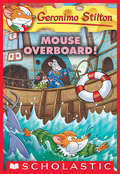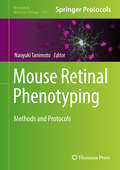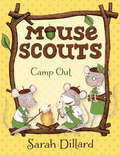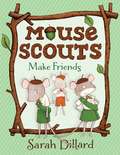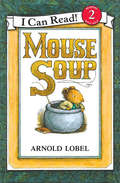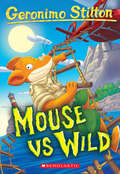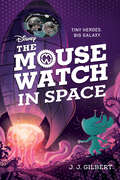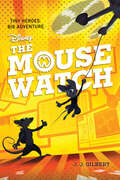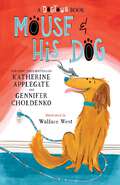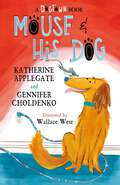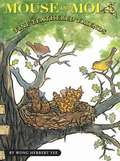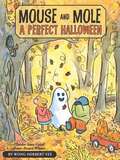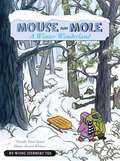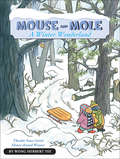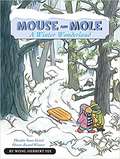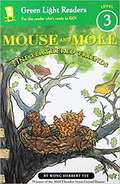- Table View
- List View
Mouse Models of Cancer
by Robert Eferl Emilio CasanovaThis volume is essential for geneticists, molecular biologists, biochemists, and medical doctors interested in the use of mouse models in cancer research. Recent genome studies, together with refined genetic engineering techniques, have greatly increased the value of using mice for research on cancer and other human disorders. The chapters of this book will support scientists in choosing the most suitable mouse models for their research questions. The book provides detailed methodological information for genetic or chemical induction of different types of cancer, histomorphometric cancer analysis, and in vivo imaging, as well as protocols to investigate oncogene addiction, immune surveillance, and hallmarks of cancer such as angiogenesis or metastasis. Four review-like articles provide background information on mouse technologies and histopathologic differences between mouse and human cancers. The mouse models described in individual chapters will fuel the understanding of cancer initiation, immune system roles, tumor angiogenesis, invasion, metastasis, and the relevance of molecular diversity observed among human cancers. Written in the highly successful Methods in Molecular Biology series format, chapters include introductions to their respective topics, lists of the necessary materials and reagents, step-by-step, readily reproducible laboratory protocols, and tips on troubleshooting and avoiding known pitfalls. Cutting-edge and resourceful, Mouse Models of Cancers: Methods and Protocols, is a valuable laboratory resource for all researchers, from the graduate level upwards, who study cancer and new possibilities for its treatment.
Mouse Models of Human Blood Cancers
by Shaoguang LiIn this book, Dr. Li and his author team plan to emphasize why mouse models are useful in vivo systems for understanding disease mechanisms and developing therapeutic strategies in blood cancers. The authors do not intend to cover all types of blood cancers; instead, they will focus on some major ones such as leukemias and lymphomas. However, the authors will try to cover as much as they can the cancer types and point out that many blood cancers need to be studied in mouse disease models although they are still not available at present. A major focus in the book will be to show what we can or cannot learn from mouse disease models and to also show the critical contributions of mouse models in therapeutic drug development.
Mouse Noses on Toast
by David Roberts Daren KingWhen Paul Mouse overhears a customer in a restaurant ordering mouse noses on toast, he assumes it must be a joke. Mouse noses on toast is a myth, isn't it? But when the waiter asks if that would be with or without whiskers, Paul knows it's no joke. So begins a laugh-out-loud funny ride involving mouse activists and cheese addicts. Along with his friends-- Sandra the Christmas tree ornament, Rowley Barker Hobbs, a shaggy sheepdog, and the Tinby, a sort of monster, Paul Mouse, who's sadly allergic to cheese, campaigns to bring an end to this disgusting human eating habit. This inviting chapter book will keep young readers giggling.
Mouse Overboard! (Geronimo Stilton #62)
by Geronimo StiltonWhen you're with Geronimo Stilton, it's always a fabumouse adventure!My family and I, Geronimo Stilton, were invited to Lisbon, Portugal, to retrace the journey of the great explorer Vasco da Gama. He was the first European to reach India by sea -- and was apparently an ancestor of the Stiltons! But once we got on the boat, I learned that someone was trying to sabotage the voyage. Could I figure out who?
Mouse Paint
by Ellen Stoll WalshThis is a delightful book. Let three white mice help your children learn about colors and what happens when paints are mixed.
Mouse Paint: Lap-Sized Board Book
by Ellen Stoll WalshPerfect for fans of Lois Ehlert and Press Here, this charming picture book gently explores the world of color and celebrates the joy of creativity. One day three white mice discover three jars of paint--red, blue, and yellow. But what happens when they splash in the colors, mixing the red and blue? Or dance in the blue and yellow? This playful introduction to colors will appeal to any budding artist or curious preschooler.
Mouse Retinal Phenotyping: Methods And Protocols (Methods In Molecular Biology #1753)
by Naoyuki TanimotoThe aim of this volume is to provide a wide range of techniques and aspects of mouse retinal phenotyping and characterization. Chapters guide readers through morphological and functional properties of the mouse retina and techniques for the analysis of outer to mid-retina and mid- to inner retina. Written in the highly successful Methods in Molecular Biology series format, chapters include introductions to their respective topics, lists of the necessary materials and reagents, step-by-step, readily reproducible laboratory protocols, and tips on troubleshooting and avoiding known pitfalls. Authoritative and cutting-edge, Mouse Retinal Phenotyping: Methods and Protocols aims to ensure successful results in the further study of this vital field.
Mouse Scouts: Camp Out
by Sarah DillardBadges are better when you earn them together! The Mouse Scouts are ready to earn a new badge . . . but can they make it in the wild without their fearless leader? The Scouts are hitting the nature trail to earn their "Camp Out" badge. But not all of the troopers are gung-ho about sleeping beneath the stars. Violet can't bear the thought of leaving her comfy bed behind, while everything about the great outdoors seems to make Junebug sneeze. But when Miss Poppy goes missing, can the Scouts work together to track down their troop leader? Brimming with lively black-and-white illustrations--including pages from the official Mouse Scout Handbook--these darling stories about the smallest Scouts with the biggest hearts are just right for fans of Ivy and Bean. "Strong characters plus lots of laughs make this a welcome series for new readers." --Kirkus Reviews
Mouse Scouts: Make Friends
by Sarah DillardBadges are better when you earn them together! The Mouse Scouts think their newest badge should be a cinch. But can old friends and new friends work side by side?When Miss Poppy assigns the troop a new badge--Making Friends--the girls think it will easy. They're already friends, so what more is there to do?! But when the Acorn Scouts learn they will need to team up with the boys in the Maple Scouts as part of the badge, everything changes. Suddenly, Tigerlily seems more interested in hanging out with her Maple Scout pal than in being friends with Violet. Friendships will be tested and opposites will find they have more in common than they thought as the Acorn Scouts figure out what it takes to be true friends.Brimming with lively black-and-white illustrations--including pages from the official Mouse Scout Handbook, plus diagrams, games, activities, and more--this darling series is just right for chapter book readers.
Mouse Sees the World! What Animals Eat
by Kuntie Ramdat BalkaranThis is a story about a mouse venturing on a world tour, and meeting different animals and their ways of life.
Mouse Shapes
by Ellen Stoll WalshWhat can you make with one oval, two circles, and eight triangles? Just ask three clever mice--who even find a funny way to trick a sneaky cat. Ellen Stoll Walsh once again proves that she's a master of concept books in this celebration of shapes, color, and innovation.
Mouse Soup
by Arnold LobelAn inventive mouse escapes from a weasel's soup pot by telling four marvelousstories. "An artistic triumph, with enough suspense, humor and wisdom to holdany reader". --New York Times. Three-color illustrations. Copyright © Libri GmbH. All rights reserved.
Mouse Soup (I Can Read Level 2)
by Arnold LobelAnother sweet bedtime story about Mouse, from Arnold Lobel, the beloved author and illustrator of the Newbery Honor and Caldecott Honor award-winning Frog and Toad books. Weasel is ready for his dinner, and poor Mouse is it. Can Mouse stop Weasel from serving up mouse soup for supper? The clever mouse tells the weasel four stories to make the soup tasty—then manages to trick the weasel and get home safely.Arnold Lobel's Mouse Soup is a Level Two I Can Read book, geared for kids who read on their own but still need a little help. Whether shared at home or in a classroom, the engaging stories, longer sentences, and language play of Level Two books are proven to help kids take their next steps toward reading success.
Mouse VS Wild (Geronimo Stilton)
by Geronimo StiltonWhen you're with Geronimo Stilton, it's always a fabumouse adventure!Trap had finally talked me into taking a relaxing vacation. But it turned out it wouldn’t just be given to me. We were going to have to win it! I was on my way to Port Stinky to win a race against the wild. Could I stand the smell long enough to win?
Mouse Watch in Space, The-The Mouse Watch, Book 3 (The Mouse Watch)
by J. J. GilbertYou've heard of the Rescue Rangers. Now meet the Mouse Watch! Hot off their successful mission in THE MOUSE WATCH UNDERWATER, Bernie and Jarvis are tapped to join the most important mission yet: one that will take them into outer space! The task? To take the Milk Saucer energy source they recovered from Cat-Lantis and connect it to a satellite that's currently circling the earth in order to halt the effects of global warming, and basically save the world. It's a huge honor to be chosen for this dangerous and historic mission. There's just one problem: Bernie is terrified of outer space. Luckily, Bernie and Jarvis will be training with one of the most famous Astro-Rodents of all time, a brave hamster by the name of Commander Sleekwhisker. As Sleek takes them through the mission and teaches them all about their ship, the U.S.S. Mozzerella, Bernie starts to think everything will be fine. But once they're launched into space and far from Gadget Hackwrench and everyone they know and love, a huge betrayal is revealed and Bernie and Jarvis find themselves trapped by members of the nefarious R.A.T.S—on the moon! Bernie might have been getting used to the idea of being in space for a few days—but not forever. Now it's up to Bernie and Jarvis to break out of lunar prison and stop the R.A.T.S., who are launching a secret army of rodent robots from their lunar base. With the help of the most adorable alien mouse ever, they just might make it back to earth in time to save the world from certain destruction. "Mice in Black" meets "Mission Im-paw-sible" in this high-stakes third novel in the Mouse Watch series.
Mouse Watch, The-The Mouse Watch, Book 1 (The Mouse Watch)
by J. J. GilbertYou've heard of the Rescue Rangers. Now meet the Mouse Watch.Around the globe, exceptional mice live in the shadows. Under the direction of famed mouse inventor Gadget Hackwrench, they work together as a team to solve BIG problems using SMALL gadgets. They are high trained. They are nearly invisible. And they love cheese. Their mission: save the world. Bernadette is a small—but brave—mouse with a score to settle. Jarvis is a sensitive rat with a big appetite and unmatched puzzle-solving skills. Both are eager to prove their worth as the youngest, newest recruits to the Mouse Watch.But before their first day of training is through, Bernie and Jarvis find themselves at the center of an evil plot orchestrated by the Rogue Animal Thieves Society (R.A.T.S.). Soon they are catapulted from new recruits into full-on action heroes, as they learn how to work together to save the Mouse Watch—and the world as they know it.Mission Impossible meets "Mice in Black" in this action-packed middle grade adventure that will take readers on an epic thrill ride and leave them ready to join the Watch!
Mouse and Hippo
by Mike TwohyMouse creates a painting for his new friend Hippo—and Hippo returns the kindness in an unlikely way—in this delightful story about doing your best to make a friend happy! <P><P>Mouse offers to paint a portrait of his new friend Hippo, but Hippo doesn’t quite fit on Mouse’s canvas. Still Hippo is delighted. In return, Hippo returns the favor for his new friend in the best way he knows how. In a surprising story sure to cause giggles, picture book readers will ask for this book over and over again! <P><P>Lexile Measure: AD490L
Mouse and His Dog: A Dogtown Book (A Dogtown Book #2)
by Katherine Applegate Gennifer CholdenkoAn Instant NEW YORK TIMES and Indie Bestseller!The not-to-be-missed companion to Dogtown, full of friendship and adventure!Mouse lives in Dogtown, a shelter for real dogs and robot dogs, where the kibble is plentiful, and the rafters hide a secret community of mice. His unlikely best friend is Buster, a big-hearted real dog who attracts trouble like a burr to fur.Determined to help Buster find his forever home, even if means losing his best pal, Mouse embarks on a bold quest with three of Dogtown’s “unadoptables”: Buster, Stewie--a huge, lovable dog whose ex-owner said he was mean, and Smokey--a robot dog hardwired with a smoke alarm he can’t control.But Mouse is just a mouse, and the world is big and complicated. How’s a little guy supposed to find homes for the dogs he loves?
Mouse and His Dog: A Dogtown Book (Dogtown #2)
by Katherine Applegate Gennifer CholdenkoFrom beloved authors Katherine Applegate and Gennifer Choldenko, Mouse and His Dog is an uplifting story and a page-turning adventure.Dogtown is a shelter for stray dogs, misbehaving dogs, and discarded robot dogs, whose owners have outgrown them.Buster is a big-hearted dog who couldn't attract more trouble if he tried.Stewie is a huge, loveable dog whose ex-owner said he was mean. And Mouse is a mouse, who has the run of Dogtown and happens to be Buster's best friend in the world.Determined to help Buster find his forever home, Mouse, Stewie, Buster and a robot-dog called Smokie embark on a bold quest in search of the perfect family. With peril, adventure and lots of laughter along the way.
Mouse and Mole Fine Feathered Friends
by Wong Herbert YeeIt is a blustery spring day, and Mouse and Mole are very excited. They are going to go bird watching! They are planning to make bird books! Mouse and Mole pack paper and crayons and hurry outside. It turns out, birds are not so easy to watch. Splashing in puddles scare them away. Stepping on crunchy leaves does too. <P><P> Mole rubs his snout. Mouse twirls her tail. Together, they come up with a plan to get closer to the birds. A plan that includes glue and feathers...<P> Join Mouse and Mole on another high-flying adventure in which teamwork, brainstorming, and good ideas always make for a fun day out!<P><P> Winner of the Theodore Seuss Geisel Honor
Mouse and Mole: A Perfect Halloween (A Mouse and Mole Story)
by Wong Herbert YeeShare another vibrant autumn season with Mouse and Mole in the sixth installment of this Geisel Honor Award–winning series."Eeny, meeny, miny, mumpkin —Which of you will be my pumpkin?&” Mouse likes Halloween. In fact, Mouse loves Halloween. And with only a few days to go before the big day, Mouse has lots of preparations to make. There are decorations to hang up and pumpkins to carve — especially for the big pumpkin-carving contest! Mole does not like Halloween nearly as much. It is scary. It is creepy. And who left that broom on the front step? Thankfully a pumpkin-carving contest is not too scary. But the pumpkin-carving contest is just the beginning of Mouse and Mole&’s Halloween adventures. What&’s Mouse to do when her best friend has turned into a big Scaredy-Mole?Theodor Seuss Geisel Honor Award Winner Wong Herbert Yee is a master of combining text and illustration for this age group. His onomatopoeic language paired with his vibrantly stylized illustrations make for an early reader series that is both artful and accessible.
Mouse and Mole: A Winter Wonderland
by Wong Herbert YeeA story of two good friends in snowy winter - Mouse and Mole , who enjoy each other's company even they are not playing together.
Mouse and Mole: A Winter Wonderland (A Mouse and Mole Story #5)
by Wong Herbert YeeShare another vibrant autumn season with Mouse and Mole in the sixth installment of this Geisel Honor Award-winning series. "Eeny, meeny, miny, mumpkin -Which of you will be my pumpkin? Mouse likes Halloween. In fact, Mouse loves Halloween. And with only a few days to go before the big day, Mouse has lots of preparations to make. There are decorations to hang up and pumpkins to carve - especially for the big pumpkin-carving contest! Mole does not like Halloween nearly as much. It is scary. It is creepy. And who left that broom on the front step? Thankfully a pumpkin-carving contest is not too scary. But the pumpkin-carving contest is just the beginning of Mouse and Mole's Halloween adventures. What's Mouse to do when her best friend has turned into a big Scaredy-Mole? Theodor Seuss Geisel Honor Award WinnerWong Herbert Yee is a master of combining text and illustration for this age group. His onomatopoeic language paired with his vibrantly stylized illustrations make for an early reader series that is both artful and accessible.
Mouse and Mole: A Winter Wonderland (Fountas & Pinnell LLI Blue #Level L)
by Wong YeeBest friends Mouse and Mole enjoy playing in the snow with Sno-Mouse and Sno-Mole, two more best friends.
Mouse and Mole: Fine Feathered Friends (Fountas & Pinnell LLI Blue #Level L)
by Marjorie WeinmanWong Herbert YeeIt is a blustery spring day, and Mouse and Mole are very excited. They are going to go bird watching! They are planning to make bird books! Mouse and Mole pack paper and crayons and hurry outside. It turns out, birds are not so easy to watch. Together, they come up with a plan to get closer to the birds... a plan that includes glue and feathers.
